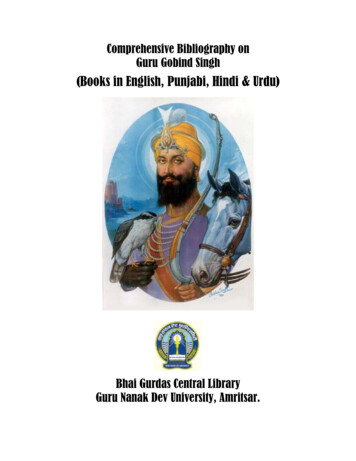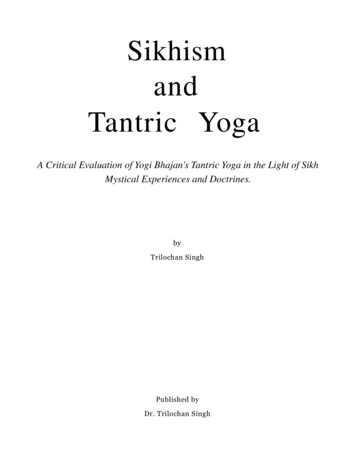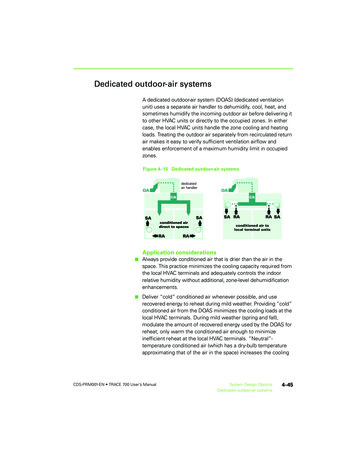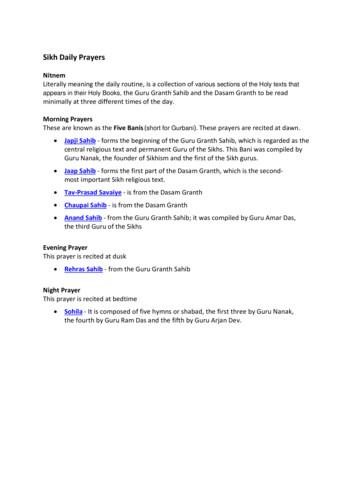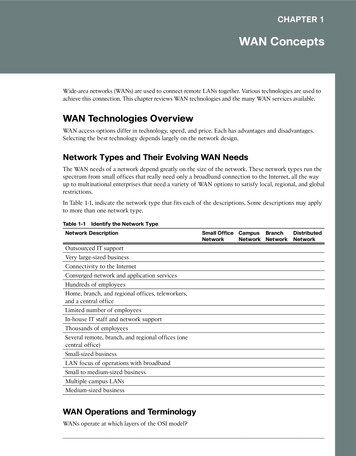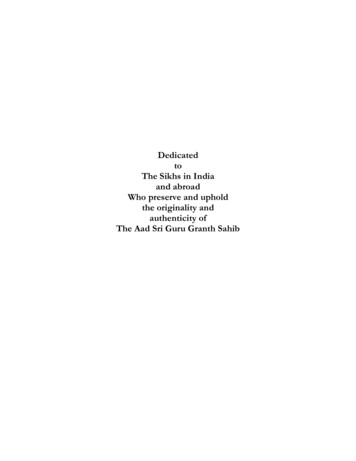
Transcription
DedicatedtoThe Sikhs in Indiaand abroadWho preserve and upholdthe originality andauthenticity ofThe Aad Sri Guru Granth Sahib
mUl-mMqrMUL-MANTAR siqnwmkrqwpurKuinrBauinrvYrAkwl mUriqAjUnI sYBMgurpRswidEk OmkarSatnamKartapurkhNirbhauNirvairAkal MuratAjuni SaibhanGur parshadMUL-MANTAR IN AUTHENTIC GURU GRANTH COPIESMul-Mantar and Gur-Mantar in Sikh scriptures have been one and the same ever since they wererevealed to Guru Nanak. They have come down to us only through written tradition. Cult-groups virtuallydisassociated from Sikhism even during the Guru-period have tried to corrupt the Mulmantar, Gurmantar andalso distort Gurbani, but the Mulmanlar and gurmantar of Guru nanak has been recorded in all authenticrecensions of Aad Sri Guru Granth Sahib, historically acceptable Janamsakhis, Gurbilases is absolutely correct,the correct Mulmantar isEk : The One Transcendent GodOmkar : All-pervading Immanent SpiritSatnam : His Name is Eternal TruthKarta Purkh : Creator, Perfect BeingNirbahu : Without FearNirvair : Without EnemityAkal murat : Immortal His divine ImageAjuni : Unborn Saibhan ; Self-ExistentGurparshad : By his Grace attainedThe Mulmantar is based on Guru Nanak’s experience and vision of the Unmanifest Absolute one andonly one God, and His Manifest Immanent, all-pervading Light Omkar. This ek Omkar is also called the Bijmantar and is present in all invocations. The divine Attributes of God are given in the Mulmantar. It embodiesthe luminosity of the Unmanifest Absolute God and His All-pervading Light which gives Life and divinespeak to all living creatures. It unfolds a vision of the Ultimate Reality and the Creative Power behind theuniverse.Contemplation and meditation on the Mulmantar opens the inner most being of man to the spiritualconsciousness of the Immanent and Transcendent Presence of God. In the Guru Granth we find it in 33places, besides being placed at the opening of new Ragas it is particularly attached to two major compositionsof Aad Guru Granth Sahib namely Japji and a-Ki-Var. It appears it was inseparably associated with theseimpositions from the time of Guru Nanak.Minor Invocations: For invocations as minor sub-headings a part of it ek Omkar satnam kartapurkh gurprashadis used only eight times, while a still shorter invocation ek Omkar satgurprashad is used 525 times. These minorinvocations are not Mulmantras. They are used even while writing a letter. For writing encyclic letters(Hukamnamas) these invocations were still reduced to brief statements and ekomkar guru sat. Guru GobindSingh introduced a number of other invocations such as Vahguru-Ji-Ki Fateh, tav prashad, Akal Sahai. TheseInvocations are not mantras and are not used for meditations.
.21.22.23.24.25.26.27.28.29.CONTENTSENGLISH SECTIONPrefaceForewordIntroductionBlasphemous attacksMannAn Academic Analysis of a Ph D ThesisMyth of early draft of Adi Granth(Manuscript 1245)The Text & Meaning of Adi GranthManuscript : A post 1606 Collection.Goindwal Pothis : A post 1595 productionPashaura Singh’s “The Text &meaning of Adi Granth”If it is a Ph D Thesis .?The Text & Meaning of the Adi GranthCan Pashaura Singh be defended?Pashaura Singh’s Thesis on “The Text &Meaning of Adi Granth”Research-Coverage of BlasphemySacrilege in the name of ResearchText & Meaning of Adi Granth :Pashaura SinghThe Text and Meaning of Adi GranthPashaura Singh :Provocative, contentious, ControversialMul-Mantar RevelationYou call it a research Dr McLeod?Pashaura Singh’s Thesis on Adi GranthCentre of Sikh Studies or BlasphemyMul-Mantar RevelatoryPashaura Singh & his Thesis - An AnalysisPathology of Pseudo-Sikh Researchers withLinear, Myopic, Left Brain, and MystifiedWestern RealitiesAad Bir Bare (Punjabi)Gurbani Sampadan Nirnai (Punjabi)Blasphemy Prohibited not researchDr. Gurnam Kaur and Dr. Kharak SinghDr Gurmel Singh SidhuDr Balwant Singh DhillonDr Balkar SinghDr Kharak Singh MannDaljeet Singh & Dr Kharak Singh MannRanbir Singh SandhuDr Darshan SinghDr Devinder Singh ChahalGurtej SinghDr Trilochan SinghDr Surinder Singh KohliProf. Manjit Singh SidhuGurbax SinghI.J. SinghKuldeep SinghDr Piara SinghDr. Hakim SinghIqbal Singh SaraDr. Sukhmander SinghDr Jasbir Singh MannSikh Missionary Centre MichiganDr S.S. SodhiProf. Sahib SinghPrincipal Harbhajan SinghDr Gurdarshan Singh Dillon
APPENDIXA.B.C.D.E.F.G.H.Xerox copy of death dates & page in Manuscript 1245Xerox Copy of a leaf from Goindwal Pothi Vol. ILetter to Dr McLeodDr Jasbir Singh MannWill Dr O’Connell respond to real issue?Dr Jasbir Singh MannLetter dated 3rd Aug. 1993 by Prof. S.S. Sodhito Dr J. Robert S. Prichard, President, university of TorontoReply dated 10th Sept. 1993 by Adel Sedra, Vice-Presidentand Provost, Toronto University, Toronto.Letter dated 17th Sept. 1993 by David Cook,Sent to Mr. Manohar Singh Bal,Vice-Provost, Toronto University, Toronto.Secretary, Ontario Council of Sikhs,Toronto.The future of Sikh Studies in North AmericaOur Contributors
pMjwbI Bwg(Punjabi Section)1. mu K-bMdsMpwidk2. pSorw isMG dy QIss dw Akwdimk AiDAYnfw. gurmyl isMG is DU3. gurU nwnk dyv XUnIvristI dI h Q-ilKq nM: 1245 fw. KVHk isMGmwndw qoVswr4. iek pRwcIn h Q-ilKq dI coxs. mnohr isMG mwrko5. duSmx bwq kry AnhoxIs. mnohr isMG mwrko6. is K Drm dy iKlw& iek v fI swizSs. hrijMdr isMG dlgIr7. AMimRq kaurw ibiKAw mITIs. gurqyj isMG8. Koj-p qr jW Awid sRI gurU gRMQ swihb qy is Dw hmlw s. gurqyjisMG9. Koj dy nW qy Drm inMidAwpRo. mnjIq isMG
PREFACEAcademic Circles are aware that a group of scholars generally concerned with the Christian Missionin Punjab have been producing literature on Sikhism which is far from well researched or even unbiased. But,it is now well known that Pashaura Singh in his present work guided by the ex-missionary W.H. Macleod hasevidently crossed all limits of propriety. For, he calls a manuscript, which admittedly bears in its contents aforged ‘Nishan’ of a Guru and the date of demise of the Fifth Guru, a draft of the Aad Granth by GuruArjun. The Manuscript has no date and no name of the scribe nor any history beyond its sudden appearanceat Amritsar in 1987, when curiously Pashaura Singh started his textual research at Toronto. Surprisingly, themanuscript is understood to have on it some words in English and a few lines in Punjabi supposed to havebeen written by a professor. On the basis of this manuscript Pashaura Singh has accused the Fifth Guru ofaltering linguistically and theologically the Bani in the Guru Granth Sahib. By any measure Pashaura Singh hasgone beyond the bounds of rationality, ethics or even the Law. It is indeed amazing that such a sub-standardwork, which appears evidently motivated should have been accepted in foreign University. The only reasonfor such suprious work having been passed as academic activity could be an ignorance in the Western worldof essentials of Sikh Studies and literature on the subject.It is, evidently, the baseless, content and character of Pashaura Singh’s work that has aroused aspontaneous reaction and response from the Sikh literate world both in India and abroad. So far as the Sikhacademic world is concerned they know by now the facts of the matter. But, these are known neither to thepublic at large nor generally among the western academic world. It is this aspect of the matter which we feelneeds to be well known. Hence, the necessity of present publication so that the shoddy nature of the work isexposed and well known.The Shiromani Gurdwara Parbandhak Committee, a representative body of the Sikhs and a finalauthority on religious affairs after having received reports of two experts committees on the subject initiatedproceedings against Pashaura Singh to appear before Sri Akal Takhat to explain his acts of blasphemy. Mr.Pashaura Singh is still evading to ear apparently because he has hardly any ground to defend himself.It is our great pleasure that a galaxy of scholars, from Guru Nanak Dev University, Amritsar, PunjabiUniversity, Patiala, tjab University, Chandigarh, Institute Aramand Frappier, versity of Qubec, Canada, OhioState University, U.S.A., versity British Columbia, Vancouver, New York University, ta Clara University, C.A.,Dalhousie University, Dr. ochan Singh, Editors of Sikh Journals, many other idemicians and representativesof Sikh Organisations have tributed to this book by their thoughtful and valuable writings.It is under the inspiration and blessings of the Guru that this ik has been undertaken and the projectwas completed hin a short period. Because of pressures and the need to ig out the publication early, the errorsand omissions in it deeply regretted.We also take this opportunity profusely to thank all the olars who have very kindly contributed theirarticles for this book.We are deeply grateful to the members of this organisation for their generous help in publishing ofthis book. In this regard our thanks are also due to Dr. Bishan Singh Samundri, Formerly Vice - Chancellor,Guru Nanak Dev University, u-itsar, for writing a forword.In the end, we should suggest to the S.G.P.C., Chief Khalsa van and other Sikh Organisations inIndia and abroad to see proper distribution of this book amongst all circles, so that y become aware of theTruth of the matter and get educated order to take adequate measures to stop any mischief of this kind.Dated : 19th January, 1994PARAMJIT SINGHAdvocateSecretaryInternational Centre of Sikh Studies,Chandigarh
FOREWORDIdeological challenge is a normal phenomenon not uncommon in the history of religious thought. Infact it may even by desirable, since it leads to better understanding of religious doctrines and provides anopportunity to its adherents to affirm their faith. Sikhism has faced such challenges in the past. Because of itsorigin and history Sikhism has often been confused with Hinduism, and described as one of its sects. Such aview has often been expressed not only by opponents of Sikhism, but also by those whose study of it issuperficial or casual. No one can ignore the too visible existence and achievements of the Sikh movement andthe transformation of society from a divided down-trodden and helpless lot to a virile and proud communitybased on a degree of equality unknown to humanity in earlier history.While well-meaning quarters of the Hindu society have always been anxious to retain this powerfulcommunity as its limb, though the Sikhs have, without wavering from their ideological course, alwaysmaintained close and fraternal ties with it throughout history. Even at the time of the Partition of India in1947, when the country was divided on a communal basis, Sikhs decided to throw in their lot with India,spurning offers of autonomy in the India subcontinent from the ceding Muslim community. The decisioncost millions of Sikhs their very hearts and homes and their fertile lands and property. In this migration lacslost their lives, and the community underwent suffering on a scale unparalleled in human history. It is noexaggeration to say that it was largely the Sikhs who paid for the freedom of India in blood, distress andproperty. Since the Sikhs have a long history of struggle for their political rights culminating in the goryevents of 1984, any suggestion that Sikhs are Hindus, has obviously political implications for the socioreligious identity of the Sikhs. Unfortunately, ideological challenges, motivated or otherwise, have been madewith renewed zeal, saying that Sikhism is a part of the Vaishnava Bhakti or Sant movements. Such claimsignore two obvious facts. Sikhism is a whole-life religion, which is strictly mono-theistic and is committed toperfect egalitarianism, householders life and acceptance of social responsibility. The system is opposed to theearlier Indian tradition that believes in personal salvation, social hierarchy, withdrawal and sanyasa as religiousvalues. Since the divergence on these basic issues is too glaring, it was not difficult for Sikh scholars to meetthe challenge. Such attacks were effectively repulsed in the end of the last century by leaders of the SinghSabha Movement as also during the present century.Recently, however, the situation has taken a different turn. Opponents have blatantly started strikingat the very roots of the Sikh faith. The challenge is directed at the authenticity and integrity of Aad Sri GuruGranth Sahib, which is not only the sole Scripture of the Sikhs, but their Living Guru, embodying the spirit ofthe Ten Masters. Pashaura Singh’s thesis supervised by an ex-missionary of Batala is an example in question.It was followed closely by a publication of Piar Singh. Both came out with preformulated and hereticalpropositions based on bogus and purposely selected material, suggesting a motivated attempt.It is indeed very unfortunate that Pashaura Singh’s attack on the authenticity of Guru Granth Sahib issought to be based on a manuscript called a draft by Guru Arjun Dev, when its text bears in its contents thedate of demise of the Fifth Master. It is also unfortunate that use has been made of an article of doubtfulauthorship, because the recorded name is considered to have been wrongly used. Such tactics can hardly docredit to a scholar or to any academic institution.It is gratifying that Sikh scholars as well as the common man, took the challenge as soon as it came.The SGPC also took cognizance of the attack. The present volume is a story of the spontaneous reaction ofthe community to the blasphemous attacks on Sikhism, and it thoroughly exposes the designs of the quartersknown for their hostility to Sikhism. I congratulate the scholars and the publishers for the production andpublication of this important material in one volume for the benefit of readers so that they know the truth.Amritsar,December 25, 1993Dr. Bishan Singh SamundriFormerly Vice-Chancellor,Guru Nanak Dev University,Amritsar
1INTRODUCTIONIn recent months some developments have taken place, which have created the necessity of bringingout the present publication. One of them is the production of two volumes. The first is a Ph.D. thesis by onePashaura Singh of Toronto University, supervised by W.H. McLeod, who makes the blasphemous statementthat Guru Arjun changed, theologically and linguistically, the bard or hymns of Guru Nanak, and having donethat, he passed these reconstituted hymns as the actual bani of Guru Nanak. The entire thesis of PashauraSingh seeks to support the above proposition, and to attack the theological and linguistic originality andauthenticity of the Aad Granth, now Guru Granth Sahib. This has been followed by publication of a smallbook, ‘Studying the Sikhs’, which comprises mostly generalised or defensive statements in justification of theearlier work of W.H. McLeod and his erstwhile colleagues in the Batala Mission, who have been criticised forsome of their misleading, incorrect and even blasphemous statements. As expected, there was strong andspontaneous reaction to the work of Pashaura Singh, in the Sikh academic world in India and abroad. Thisreaction has been twofold. First is the proceedings of blasphemy initiated by the SGPC, Amritsar, afterobtaining reports of two expert committees of Gurmat and university scholars, against Pashaura Singh beforethe Akal Takht. The second part is the publication of a large number of reviews, papers and articles by wellknown academicians who criticised the work of Pashaura Singh as ‘blasphemous’, and his findings‘preconceived’, ‘baseless’, and ‘motivated’.Since it is believed that the thesis of Pashaura Singh supported by McLeod, an ex-missionary fromthe Punjab Missionary organisation, is in continuation of the thinking and objectives of the Batala Group, it isnecessary first to give the background, approach and history of some of its scholars, and to state concisely thesubstance and slant of Pashaura Singh’s Thesis, and the criticism embodied in the 34 papers that form thebody of this publication.The Background and Approach : The Christian Mission appeared in the Punjab soon after the annexationof the state by the British in the middle of the last century. Almost since its inception, it has, apart from doingnormal missionary activities, simultaneously been producing literature, subversive to the identity and growthof other religions, particularly Sikhism. It is well known that the reaction of the Singh Sabha was partly due tothese activities of the Mission working under the wings of the British Administration. At one time, theMission declared that three Sikh boys of their school at Amritsar would be openly converted to Christianityand their hair publically shaved.In order to understand the approach of the missions in Punjab, it is relevant to give the followingdecision of the World council of Churches made in one of its meetings. A proposal was made by the NorthAmerican Churched that, because of the danger of Secularism, Christian Churches should seek the cooperation of other religions in order to create a common front against the danger of Secularism. MetropolitanPaulo Mar Gregorios, a former Chairman of the World Council of Churches, reports: “The American viewwas that there are three realities : Christianity, other Religions, and’ Secularism, and that these three realitiescan either be allies- or enemies. It was argued that the Christians had to choose whether they were to allythemselves with other religions against Secularism. The Americans, especially the Boston Personalists, whowere leading the debate at that time, took the view that Secularism is a common danger for all religions, and,therefore, there must be an alliance of all religions to fight Secularism. European theologians, particularlyBarth, Brunner, and Kramer, took a totally different view. They maintained that Secularisation, notSecularism, is the primary process. It is a process in which some of the values of the Christian faith have beenput into a secular framework, bringing about a powerful force which is destroying all old ideas. HenceSecularisation is an ally, because it will destroy Hinduism, Islam and other forms of what they considered tobe superstition. So we should ally ourselves with Secularisation, and see it as the work of God. That wasBonhoffer’s, Barth’s, and Kramer’s point of view.”
“A similar debate took place in 1932 or 1933 in Madras at the next Missionary Conference. There theAmerican point of view was totally defeated.” “One of the books published during that era by Emil Brunner,the Swiss theologian, was called ‘Either/Or’. In it Brunner argued that the Christian Gospel has overcome allits enemies except one, and that is mysticism. Mysticism is an enemy, because it claims that you can haveunmediated access to God, and as long as you can have unmediated access, there is no use for Jesus Christ.Therefore, mysticism is the only remaining enemy, and one has to make a clear choice : either the Gospel orMysticism.”“That is why at the World Council of Churches it was almost impossible to begin any kind ofdialogue.”At another meeting in 1975 at Nairobi the Chairman was confronted with the observation, “We donot feel we have anything lacking. And so we are opposed to dialogue, unless it is for the sake of testifying toJesus Christ.” “That was it. Then they passed a resolution saying that under no circumstances should multireligious dialogues be undertaken, because multi-religious dialogues put Christianity at the same level as otherreligions, and this is unacceptable.”“That is the point of view that has triumphed in the World Council of Churches. Some of us are stilltrying to change that point of view, but it is difficult.”We do not say that honest attempts at inter-faith dialogue are not taking place, but the generalapproach governing missionary activities is quite clear.Even after the Akali Movement of the twenties and the Indian Independence, the work of missioncontinued in Punjab. A branch of the Mission called the Batala Group, organised a special Centre of SikhStudies, which has from time to time been producing half-baked literature that seeks in many subtle and evenunsubtle ways, to attack the institutions of Sikhism. Missionaries or ex-missionaries and their associates havebeen quite prolific in bringing out such material, and three of them, Loehlin, McLeod and McMullen, areconsidered their experts in Sikh Studies.Literature produced by this group on Sikhism and its institutions, is controversial. From bothuniversities and other institutions, a large body of criticism has appeared to show how superficial and biasedthe works of McLeod and his associates, are. Here we shall indicate only one of the blasphemous issues raisedby McLeod in his books.McLeod Attacks the Authenticity of Guru Granth Sahib :McLeod’s small volume, “Evolution of the Sikh Community”, contained an unfounded attack on theauthenticity of the Kartarpuri Bir, which forms the basis of the Guru Granth Sahib, worshipped by all Sikhsthe world over, as their living Guru. The level of the scholarship of the author is evident from the followingextracts from the reviews published in the Journal of Sikh Studies, Guru Nanak Dev University, Amritsar. “Inthe short space of 104 pages the author attempts to cover the background, origin and growth of ideology, andall the institutions of the Sikhs, and naturally the method adopted is journalistic and speculative, rather thancomprehensive and academic.” “It is the common failing of persons with mechanistic views to ignore the roleof ideas and ideology as a cementing and directing force in human history and to overstretch andoverestimate the significance of ordinary facts and routine events which otherwise, in similar circumstanceshave never shown any like potential. If oddity is originality, and conjectural assertions and assumptions piecesof historical evidence, the book abounds in them.” The assessment in the Sikh Review, Calcutta is : “DrMcLeod has turned his attention on the Sikhs and their religion with a view to giving special notoriety to hisviews on Sikhs and Sikhism as he wants to or does see it. The result is clearly a mildly and certainly aperverted version of the Sikh esoteric principles and Sikh history and its exposition. It would rank withTrumpp’s translation of Guru Granth Sahib; the Dhirmalian’s ‘Var Piran Pikambran ki’; or the contemporary,
‘the bani of nakli Nirankaris’, to mention just a few of the gems of envious literary genius ever ready to knockdown the prophetic mission and achievements of the Sikh Gurus.”This book is full of unsupported generalisations and even blasphemous statements against the GuruGranth Sahib and the Sikhs. Over the subsequent years controversies about it have continued, especiallyabout his libellous or blasphemous statement against the authenticity of the Guru Granth Sahib. Withoutgoing into many of his other unacademic statements, like, “This is widely regarded as a great pity, even withinthe Sikh society, where the numerically preponderant Jats commonly bewail the fact that there was never asingle Jat Guru.”, we shall here confine ourselves only to one issue about his statement against theauthenticity of the Kartarpuri Bir or Guru Granth Sahib, which is principally relevant to our present volume.The worst part exposing the perfunctory scholarship and the underlying motive of McLeod is that he made,and continued to repeat, these unfounded statements without examining the Kartarpuri Bir of 1604 AD,without examining the Banno Bir of 1642 AD, and without studying the related literature on the subject. Hisallegation is that Guru Granth Sahib, is a tampered with, or a forged Granth, out of which inconvenienthymns have been obliterated by the Sikhs. The Punjabi University, Patiala, published two books, the first in1968, and another in 1987, on the Kartarpuri Bir, which show that McLeod’s statements are unwarranted andbaseless. Both these books were written after examination of the Kartarpuri Bir, and testify to its authenticity.Unfortunately, knowing full well that what he was saying was incorrect, he continued with his libellousstatements in 1979 and again in 1989. Since McLeod’s allegations were considered un-called-for and offensiveto the authenticity of the Guru Granth Sahib, four academic organisations of Punjab wrote in 1989 to theUniversity of Toronto that it was very anomalous that a person who had been making blasphemousstatements against the authenticity of the Guru Granth Sahib, the Guru as well as the Scripture of the Sikhs,had not only been appointed by the University on a Chair funded by the Sikhs of Canada in order to project acorrect image of Sikhism and its institutions, but he had been making his attacks from the platform of theUniversity. As there was no response from the University, the correspondence exchanged was published.Here it is very relevant to state that of the four organisations that wrote to the University about theblasphemous conduct of McLeod, one was presided over by a former Judge of the Punjab and Haryana HighCourt and the other was headed by an ExMinister of Government and a very senior advocate of the HighCourt. They very well understood the ingredients of blasphemy, and whether or not McLeod’s statementsamounted to that. To recapitulate, the three ingredients of blasphemy are : one, that the statement should befalse; two, that the author should know to be so; and, three, that the statement should be defamatory f areligious person or body.It is, therefore, necessary to give the requisite extracts of McLeod’s statements to the readers, so thatthey can well understand the position. He published the following in his book ‘Evolution of the SikhCommunity’ of 1975; in which he alleges deletion or obliteration of a portion of the Ramkali hymn attributedto Guru Arjun: “There seems to be only one possible reason for the appearance of these two fragments. Thebulk of the hymn in each case must have been deleted, leaving a small remainder which was faithfully copiedinto the standard printed text. A fourth point seems to clinch the issue. The Banno text of the missingportion indicated good reason for later deletion, particularly in the case of Ramkali hymn by Guru Arjun. Thishymn describes the puberty rites conducted by Guru Arjun at the initiation of his son, Hargobind. The ritesfollow a standard Hindu pattern and in the third stanza there is a reference to the manner in which the boy’shead was shaved. This feature is in obvious contradiction to the latter prohibition of hair cutting. When theprohibition became mandatory not merely for Jat Sikhs, but also those of other castes, the reference in thehymn could only be regarded as intolerable.” “The conclusion that seems to be emerging with increasingassurance was that the widely disseminated Banno version must represent the original text; and that theKartarpuri manuscript must be a shortened version of the same text. A few portions must have been deleted,because they could not be reconciled with beliefs subsequently accepted by the Panth. This much appears tobe well established.” “Later still, portions of the Kartarpuri manuscript (the original manuscript written byBhai Gurdas) were ineptly obliterated in order to bring the two versions into line.”
The above statement, especially the last sentence, is a clear conclusion, without any reservation,saying that the inconvenient hymn in the Kartarpuri Bir was obliterated. And, this conclusion follows overfour pages of argumentation in support of his conclusion. To the reader the conclusion, as argued by McLebdand as arrived at by him, is a clear assertion. And yet his conclusion, as admitted by him, is false. For, on thevery page of his conclusion he writes: “Dr Jodh Singh assures us that there has been no obliteration at thepoint. He reports a similar condition in the case of Guru Arjun’s Ramkali hymn. The solitary couplet isfollowed by a blank space which extends to more than two folios - and no obliteration.” These blank spaces,as elsehwere in the text, are at the end of a raga/ and, for that reason, are natural, and nothing unusual. Thisshows that the author, when he drew the earlier inference, knew his statement to be incorrect. Because, whilehe laboured to write four pages to arrive at his inference that the Ramkali hymn had been ‘ineptly obliterated’in the Kartarpuri Bir, and this he did without examining the Kartarpuri Bir, the Banno Bir or the relatedliterature, he knew full well that Dr Jodh Singh, who had done the meticulous work of recording page by pageposition of the Kartarpuri Bir, had categorically stated that there was no obliteration of the Ramkali hymnwhatsoever. The third ingredient of blasphemy is the defamation involved in McLeod’s conclusion that theinconvenient portion of the Ramkali hymn was later obliterated by the Sikhs, when they found it to beintolerable, and for that reason the Guru Granth Sahib is a forged Granth that stood tampered with by theSikhs. Thus, defamation would, we believe, inevitably follow from the writing of the author. Hence thecomplaint of the four organisations to the University about unacademic, unethical and defamatory conduct ofits employee. Further, is the question as to whether he really gave up his inference about the tampered withcharacter of the Kartarpuri Bir after his knowledge of Jodh Singh’s book of 1968, as admitted by him in his‘Evolution of the Sikh Community’. There is no evidence whatsoever of his having given up his idea when heread his paper at Berkeley in 1976. For, there too, he clearly repeated his old assertion, “The earliest,representing nearest approach to Guru Arjun’s dictation would be Banno, the second, an intermediaterecension bearing the actual marks of a later revision through the excision of unacceptable material, would beKartarpuri.” The above statement makes it clear that there is not the least sign of his ever having retracted hisearlier stand. On the other hand, he clearly repeats his statements of Kartarpuri Bi
Dec 25, 1993 · manuscript is understood to have on it some words in English and a few lines in Punjabi supposed to have been written by a professor. On the basis of this manuscript Pashaura Singh has accused the Fifth Guru of altering linguistically and theologically the Bani in the Guru Granth
